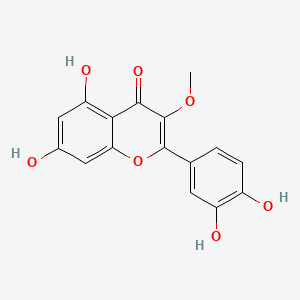| MeSH term | MeSH ID | Detail |
|---|---|---|
| Cell Transformation, Neoplastic | D002471 | 126 associated lipids |
3-O-Methylquercetin
3-O-Methylquercetin is a lipid of Polyketides (PK) class. 3-o-methylquercetin is associated with abnormalities such as Colitis, Hemorrhagic diarrhea and Diabetes. The involved functions are known as Inflammation, Trans-Activation (Genetics), Signal Transduction, Binding, Competitive and Antiinflammatory Effect. 3-o-methylquercetin often locates in Mucous Membrane. The associated genes with 3-O-Methylquercetin are IL2 gene, Human gene and ABCB1 gene. The related experimental models are Streptozotocin Diabetes.
Cross Reference
Introduction
To understand associated biological information of 3-O-Methylquercetin, we collected biological information of abnormalities, associated pathways, cellular/molecular locations, biological functions, related genes/proteins, lipids and common seen animal/experimental models with organized paragraphs from literatures.
What diseases are associated with 3-O-Methylquercetin?
3-O-Methylquercetin is suspected in Colitis, Hemorrhagic diarrhea, Diabetes and other diseases in descending order of the highest number of associated sentences.
Related references are mostly published in these journals:
| Disease | Cross reference | Weighted score | Related literature |
|---|
Possible diseases from mapped MeSH terms on references
We collected disease MeSH terms mapped to the references associated with 3-O-Methylquercetin
PubChem Associated disorders and diseases
What pathways are associated with 3-O-Methylquercetin
There are no associated biomedical information in the current reference collection.
PubChem Biomolecular Interactions and Pathways
Link to PubChem Biomolecular Interactions and PathwaysWhat cellular locations are associated with 3-O-Methylquercetin?
Visualization in cellular structure
Associated locations are in red color. Not associated locations are in black.
Related references are published most in these journals:
| Location | Cross reference | Weighted score | Related literatures |
|---|
What functions are associated with 3-O-Methylquercetin?
Related references are published most in these journals:
| Function | Cross reference | Weighted score | Related literatures |
|---|
What lipids are associated with 3-O-Methylquercetin?
There are no associated biomedical information in the current reference collection.
What genes are associated with 3-O-Methylquercetin?
Related references are published most in these journals:
| Gene | Cross reference | Weighted score | Related literatures |
|---|
What common seen animal models are associated with 3-O-Methylquercetin?
Streptozotocin Diabetes
Streptozotocin Diabetes are used in the study 'Plant flavonol isorhamnetin attenuates chemically induced inflammatory bowel disease via a PXR-dependent pathway.' (Dou W et al., 2014).
Related references are published most in these journals:
| Model | Cross reference | Weighted score | Related literatures |
|---|
NCBI Entrez Crosslinks
All references with 3-O-Methylquercetin
Download all related citations| Authors | Title | Published | Journal | PubMed Link |
|---|---|---|---|---|
| Hu S et al. | Isorhamnetin inhibits cell proliferation and induces apoptosis in breast cancer via Akt and mitogen‑activated protein kinase kinase signaling pathways. | 2015 | Mol Med Rep | pmid:26502751 |
| Park YJ et al. | Inhibitory Aromatase Effects of Flavonoids from Ginkgo Biloba Extracts on Estrogen Biosynthesis. | 2015 | Asian Pac. J. Cancer Prev. | pmid:26434836 |
| Messer JG et al. | Quercetin Metabolites Up-Regulate the Antioxidant Response in Osteoblasts Isolated From Fetal Rat Calvaria. | 2015 | J. Cell. Biochem. | pmid:25716194 |
| Jimenez R et al. | Quercetin and its metabolites inhibit the membrane NADPH oxidase activity in vascular smooth muscle cells from normotensive and spontaneously hypertensive rats. | 2015 | Food Funct | pmid:25562607 |
| Xie Y et al. | Comparison of isorhamnetin absorption properties in total flavones of Hippophae rhamnoides L. with its pure form in a Caco-2 cell model mediated by multidrug resistance-associated protein. | 2015 | Eur J Pharm Sci | pmid:25813735 |
| Maciej J et al. | Bioavailability of the flavonol quercetin in neonatal calves after oral administration of quercetin aglycone or rutin. | 2015 | J. Dairy Sci. | pmid:25795488 |
| Shaheen N et al. | Separation of isorhamnetin 3-sulphate and astragalin from Flaveria bidentis (L.) Kuntze using macroporous resin and followed by high-speed countercurrent chromatography. | 2015 | J Sep Sci | pmid:25763770 |
| Wiczkowski W et al. | Quercetin and isorhamnetin aglycones are the main metabolites of dietary quercetin in cerebrospinal fluid. | 2015 | Mol Nutr Food Res | pmid:25727325 |
| RodrÃguez-RodrÃguez C et al. | The effect of isorhamnetin glycosides extracted from Opuntia ficus-indica in a mouse model of diet induced obesity. | 2015 | Food Funct | pmid:25588195 |
| Wang H et al. | A phospholipid complex to improve the oral bioavailability of flavonoids. | 2015 | Drug Dev Ind Pharm | pmid:25496311 |
